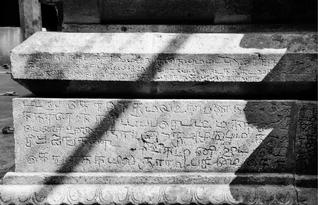As the debate continues on the ills of corruption in public life, in the interior of Krishnagiri district of Tamil Nadu,the temple of Penneshwaramadam, on the banks of the River Thenpennai, bears an inscription that reserves "an extreme form of contempt" for the corrupt in public life. It probably echoes the Supreme Court's recent verdict that termed corruption in public life "a human rights violation." In the later Chola era temple is etched the 13th century inscription of the order is sued by Hoysala ruler Veera Ramanatha, dated regnal year 46. It reads: "Anybody seeking cooked food or indulging in other corrupt practices in Pennaiyaandaarmadam and its endowed land (Pennaiyaandar devadana oorgalilum) shall be beheaded, and any official (Kannakkar, Adhigaarigal) refusing to act on this order will face a similar fate."
The translation of the inscription in the Tamil Grantha script has been recorded by Su. Krishnamoorthy of the State Department of Archaeology, says Sugava Murugan of the District Archaeology Centre. The inscription also holds to account "the public official looking the other way as much as the doer of corruption, a point that came through in the verdict in the assets case against the former Chief Minister, Jayalalithaa. There are several inscriptions that speak of imposition of fine on temple officials and confiscation of their property for pilfering temple property. Significantly, this inscription speaks of capital punishment for corrupt officials, reflecting the character of the Hoysala ruler, says an eminent archaeologist.

The Utharamerur inscriptions of 921 AD, issued by Paranthaka Chola, set out the postulates and code of conduct for contesting elections. "Even before 1000 years, the Uttharamerur inscriptions laid down elaborate rules for elections. Lying was a sin that disqualified a person from contest," says a scholar of Archaeology. They list the punishment for a corrupt public servant, including confiscation of his property and excommunication of his dependants, but have no reference to capital punishment.
The Penneshwaramadam temple also has panels of Navagandam, depicting a man holding his tuft by one hand and slicing the neck with a sword by the other. The practice of progressively chopping off nine parts of one's own body - which evokes sociologist Emile Durkheim's category of altruistic suicide - was often committed before Kottravai, the Goddess of war, for the welfare of the ruler and success in battles he leads.
The practice is similar to the present day personality cult in Dravidian politics and self -immolation bids and suicides that Tamil Nadu witnessed after the conviction of Ms.Jayalalithaa, says Sugavana Murugan, who has written about the inscription in the now-defunct literary journal Vadakku Vaasal, which was published from Delhi.
sources from the hindu date:11-10-14.
|
|
Disclaimer:
This web page explains the corruptions that occured in India. The information are collected from the media reports. www.indianmirror.com or it owners do not take any responsibility for the authenticity of the contents. Since some cases are in the court of law, we do not endorse any cases or do not conclude on the same.
If you need any changes to be done on the above information, kindly contact us with valid proof. However sincere attempt is being made to create awareness in the society against this evil and to prepare the younger generation for a corruption free India.
|



